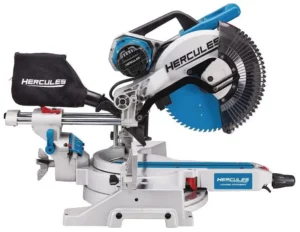
HERCULES HE74 12-Inch Double-Bevel Sliding Compound Miter Saw

WARNING: To prevent serious injury, User must read and understand Owner’s Manual. SAVE THIS MANUAL.
When unpacking, make sure that the product is intact and undamaged. If any parts are missing or broken, please call
1-888-866-5797 as soon as possible. Reference 63978.
IMPORTANT SAFETY INFORMATION
GENERAL TOOL SAFETY WARNINGS
WARNING
Read all safety warnings and all instructions. Failure to follow the warnings and instructions may result in electric shock, fire and/or serious injury. Save all warnings and instructions for future reference.
- KEEP GUARDS IN PLACE and in working order.
- REMOVE ADJUSTING KEYS AND WRENCHES. Form habit of checking to see that keys and adjusting wrenches are removed from tool before turning it on.
- KEEP WORK AREA CLEAN. Cluttered areas and benches invite accidents.
- DON’T USE IN DANGEROUS ENVIRONMENT. Don’t use power tools in damp or wet locations, or expose them to rain. Keep work area well lighted.
- KEEP CHILDREN AWAY. All visitors should be kept safe distance from work area.
- MAKE WORKSHOP KID PROOF with padlocks, master switches, or by removing starter keys.
- DON’T FORCE TOOL. It will do the job better and safer at the rate for which it was designed.
- USE RIGHT TOOL. Don’t force tool or attachment to do a job for which it was not designed.
Table A: RECOMMENDED MINIMUM WIRE GAUGE FOR EXTENSION CORDS (120 VOLT)
NAMEPLATE AMPERES (at full load)
EXTENSION CORD LENGTH 25′ 50′ 100′ 150′ 0 – 6 18 16 16 14 6.1 – 10 18 16 14 12 10.1 – 12 16 16 14 12 12.1 – 16 14 12 Do not use. - USE PROPER EXTENSION CORD. Make sure your extension cord is in good condition. When using an extension cord, be sure to use one heavy enough to carry the current your product will draw. An undersized cord will cause a drop in line voltage resulting in loss of power and overheating.
Table A shows the correct size to use depending on cord length and nameplate ampere rating.
If in doubt, use the next heavier gauge.
The smaller the gauge number, the heavier the cord. - WEAR PROPER APPAREL. Do not wear loose clothing, gloves, neckties, rings, bracelets, or other jewelry which may get caught in moving parts. Nonslip footwear is recommended. Wear protective hair covering to contain long hair.
- ALWAYS USE SAFETY GLASSES. Also use face or dust mask if cutting operation is dusty. Everyday eyeglasses only have impact resistant lenses, they are NOT safety glasses.
- SECURE WORK. Use clamps or a vise to hold work when practical. It’s safer than using your hand and it frees both hands to operate tool.
- DON’T OVERREACH. Keep proper footing and balance at all times.
- MAINTAIN TOOLS WITH CARE. Keep tools sharp and clean for best and safest performance. Follow instructions for lubricating and changing accessories.
- DISCONNECT TOOLS before servicing; when changing accessories, such as blades, bits, cutters, and the like.
- REDUCE THE RISK OF UNINTENTIONAL STARTING. Make sure switch is in
off position before plugging in. - USE RECOMMENDED ACCESSORIES. Consult the owner’s manual for recommended accessories. The use of improper accessories may cause risk of injury to persons.
- NEVER STAND ON TOOL. Serious injury could occur if the tool is tipped or if the cutting tool is unintentionally contacted.
- CHECK DAMAGED PARTS. Before further use of the tool, a guard or other part that is damaged should be carefully checked to determine that it will operate properly and perform its intended function – check for alignment of moving parts, binding of moving parts, breakage of parts, mounting, and any other conditions that may affect its operation. A guard or other part that is damaged should be properly repaired or replaced.
- DIRECTION OF FEED. Feed work into a blade or cutter against the direction of rotation of the blade or cutter only.
- NEVER LEAVE TOOL RUNNING UNATTENDED. TURN POWER OFF. Don’t leave tool until it comes to a complete stop.
Grounding Instructions
WARNING
TO PREVENT ELECTRIC SHOCK AND DEATH FROM INCORRECT GROUNDING WIRE CONNECTION READ AND FOLLOW THESE INSTRUCTIONS:
Double Insulated Tools: Tools with Two Prong Plugs
- To reduce the risk of electric shock, double insulated equipment has a polarized plug (one blade is wider than the other). This plug will fit in a polarized outlet only one way. If the plug does not fit fully in the outlet, reverse the plug. If it still does not fit, contact a qualified electrician to install the proper outlet. Do not change the plug in any way.
- Double insulated tools may be used in either of the 120 volt outlets shown in the following illustration. (See Outlets for 2-Prong Plug.)
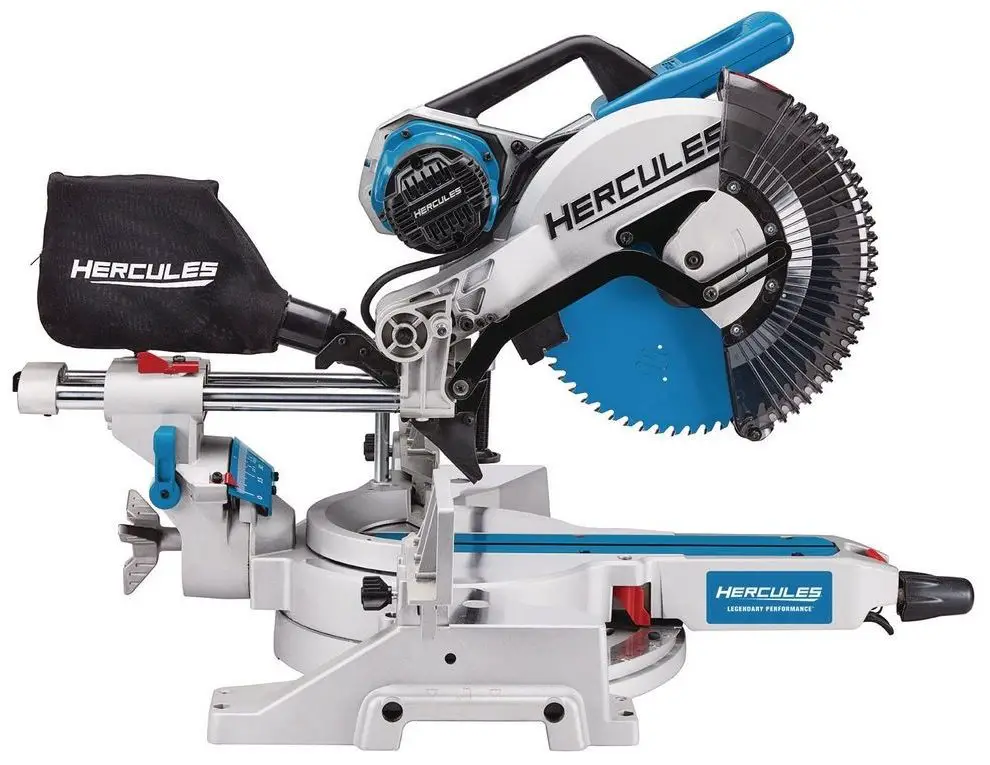
Miter Saw Safety Warnings
For Your Own Safety Read Instruction Manual Before Operating Miter Saw
- Wear eye protection.
- Keep hands out of the line of saw blade.
- Do not operate saw without guards in place.
- Do not perform any operation freehand.
- Never reach around saw blade.
- Turn off tool and wait for saw blade to stop before moving workpiece or changing settings.
- Disconnect power before changing blade or servicing.
- To reduce risk of injury, return carriage to the full rear position after each crosscut operation.
- Release lower guard retraction mechanism after each cut and before moving or removing the workpiece. Blade adjustment is to be made with the power off and the blade stopped.
- Return all guards to original position if any are moved during blade replacement. Check all guards for proper operation after service.
- The lock down pin is to be used only to lock the head in place for carrying and storage. It is not to be used for any cutting operation.
- Always use blades with correct size and shape (diamond versus round) of arbor holes. Blades that do not match the mounting hardware of the saw will run eccentrically, causing loss of control.
- Never use damaged or incorrect blade washers or bolt. The blade washers and bolt were specially designed for your saw, for optimum performance and safety of operation.
- Do not use to cut logs, tree limbs, or uneven lumber.
- Wet lumber, green (unseasoned) lumber, and pressure treated lumber all have an increased potential for kickback and should only be cut with a blade for cutting that lumber type. Wear a NIOSH-approved respirator and have appropriate ventilation whenever cutting pressure treated lumber.
- Do not use blades made from high-speed steel, abrasive blades, metal-cutting blades or masonry-cutting blades. The guards of this saw are not designed to protect against the failure of such blades.
- Blades must be rated to at least the maximum speed marked on the tool.
- DO NOT OPERATE WITH ANY GUARD DISABLED, DAMAGED, OR REMOVED. Moving guards must move freely and close instantly.
- The use of accessories or attachments not recommended by the manufacturer may result in a risk of injury to persons.
- When servicing use only identical replacement parts.
- Do not depress the spindle lock when starting or during operation.
- Only use safety equipment that has been approved by an appropriate standards agency. Unapproved safety equipment may not provide adequate protection. Eye protection must be ANSI-approved and breathing protection must be NIOSH-approved for the specific hazards in the work area.
- Stay alert, watch what you are doing and use common sense when operating a power tool. Do not use a power tool while you are tired or under the influence of drugs, alcohol or medication. A moment of inattention while operating power tools may result in serious personal injury.
- Industrial applications must follow OSHA guidelines.
- Maintain labels and nameplates on the tool. These carry important safety information. If unreadable or missing, contact Harbor Freight Tools for a replacement.
- Avoid unintentional starting. Prepare to begin work before turning on the tool.
- People with pacemakers should consult their physician(s) before use. Electromagnetic fields in close proximity to heart pacemaker could cause pacemaker interference or pacemaker failure.
- The warnings, precautions, and instructions discussed in this instruction manual cannot cover all possible conditions and situations that may occur. It must be understood by the operator that common sense and caution are factors which cannot be built into this product, but must be supplied by the operator.
Vibration Safety
This tool vibrates during use. Repeated or long-term exposure to vibration may cause temporary or permanent physical injury, particularly to the hands, arms and shoulders. To reduce the risk of vibration-related injury:
- Anyone using vibrating tools regularly or for an extended period should first be examined by a doctor and then have regular medical check-ups to ensure medical problems are not being caused or worsened from use. Pregnant women or people who have impaired blood circulation to the hand, past hand injuries, nervous system disorders, diabetes, or Raynaud’s Disease should not use this tool. If you feel any medical or physical symptoms related to vibration (such as tingling, numbness, and white or blue fingers), seek medical advice as soon as possible.
- Do not smoke during use. Nicotine reduces the blood supply to the hands and fingers, increasing the risk of vibration-related injury.
- Use tools with the lowest vibration when there is a choice between different processes.
- Include vibration-free periods each day of work.
- Grip workpiece as lightly as possible (while still keeping safe control of it). Let the tool do the work.
- To reduce vibration, maintain the tool as explained in this manual. If any abnormal vibration occurs, stop use immediately. Warning Symbols and Definitions
Warning Symbols and Definitions
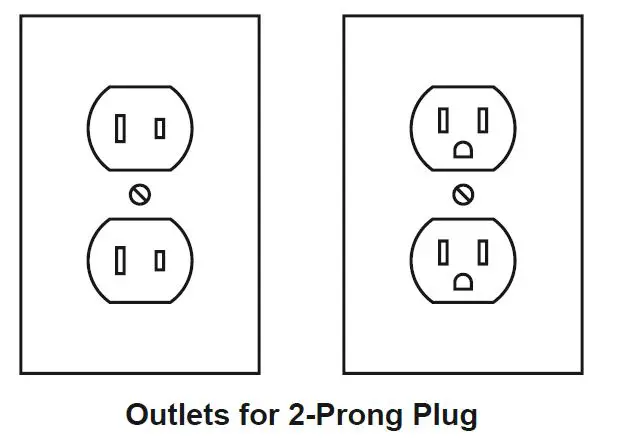
Symbology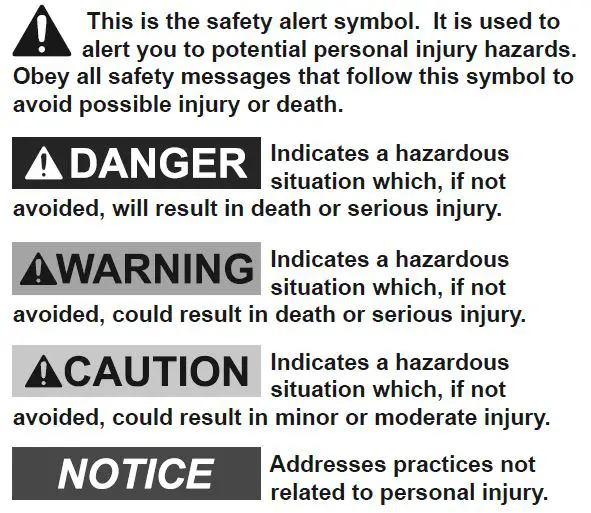
Specifications
| Electrical Rating | 120 VAC / 60 Hz / 15 A |
| Spindle No Load Speed | 4,100 RPM |
| Max. Accessory Diameter | Blade Diameter – 12″ |
| Arbor | 1″ Round |
| Capacity of Cut | 50° Miter Left / 60° Miter Right 49° Bevel Left and Right |
Cutting Capacities
| ANGLE | MAXIMUM CAPACITY OF CUT | RESULT | ||
| 0° Miter | Height | 4-1/2″ | Width | 12-1/2″ |
| Width | 14″ | Height | 3-1/2″ | |
| 45° Miter | Height | 4-1/2″ | Width | 8-1/4″ |
| Width | 9-3/4″ | Height | 3-5/16″ | |
| 45° Bevel Left | Height | 2-7/8″ | Width | 9-7/8″ |
| Width | 14″ | Height | 1-3/4″ | |
| 45° Bevel Right | Height | 1-15/16″ | Width | 12-1/8″ |
| Width | 14″ | Height | 1-5/16″ | |
Functional Description
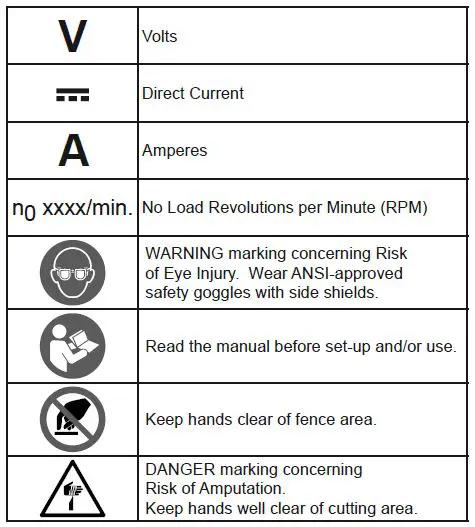
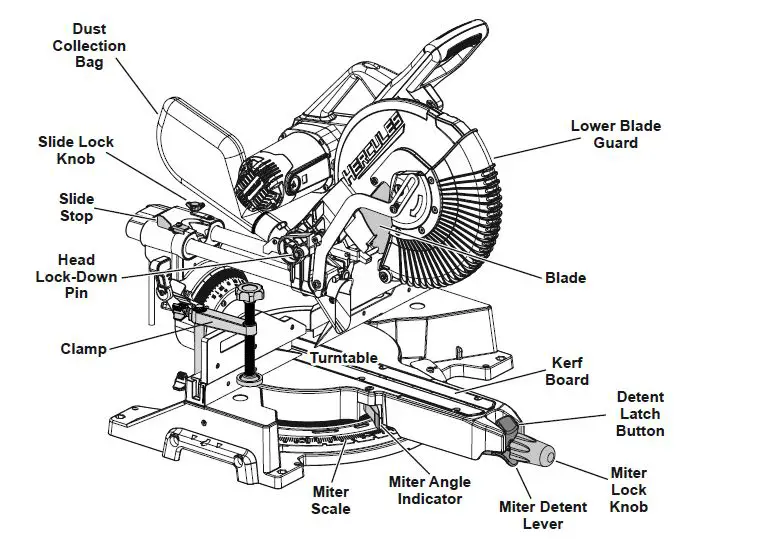
OPERATION
Read the ENTIRE IMPORTANT SAFETY INFORMATION section at the beginning of this manual including all text under subheadings therein before set up or use of this product.
TO PREVENT SERIOUS INJURY: DO NOT OPERATE WITH ANY GUARD DISABLED, DAMAGED, OR REMOVED. Moving guards must move freely and close instantly.
Tool Set Up
TO PREVENT SERIOUS INJURY FROM ACCIDENTAL OPERATION:
Turn the Power Switch of the tool off and unplug the tool from its electrical outlet before performing any procedure in this section.
Note: For additional information regarding the parts listed in the following pages, refer to the Assembly Diagram near the end of this manual.
Assembly
- Insert the four Feet (2) into the holes on the bottom of the Base (1) and tap into place.
- Thread the Miter Lock Knob (239) into the end of the table above the Miter Detent Lever until securely in place.
- Slip the Dust Collection Bag (240) over the Dust Outlet behind the saw.
Mounting
Use the bolt holes in the Base to mount the Miter Saw to a stable support before use. Mounting holes are provided in two sizes to accommodate different sizes of hardware. Mounting hardware not included.
Installing or Replacing the Blade
- Unplug the tool from its power source.
- Pull out the Head Lock-Down Pin (89), raise the Saw Head to the upper position, then raise the Lower Blade Guard (224) out of the way and hold it up.
- Loosen the Guard Plate Bolt until it disengages the Guard Plate (229).
- Swing the Guard Plate up and out of the way. Refer to Figure A.
- Press in the Spindle Lock (112) on the back of saw ‘s head and hold it
- Remove the Arbor Bolt (221) and Outer Flange (220). Refer to Figure B.
IMPORTANT: The Arbor Bolt has a left-handed thread and removes by turning CLOCKWISE.
Note: Make sure the Inner Flange (218) stays in place on the Spindle.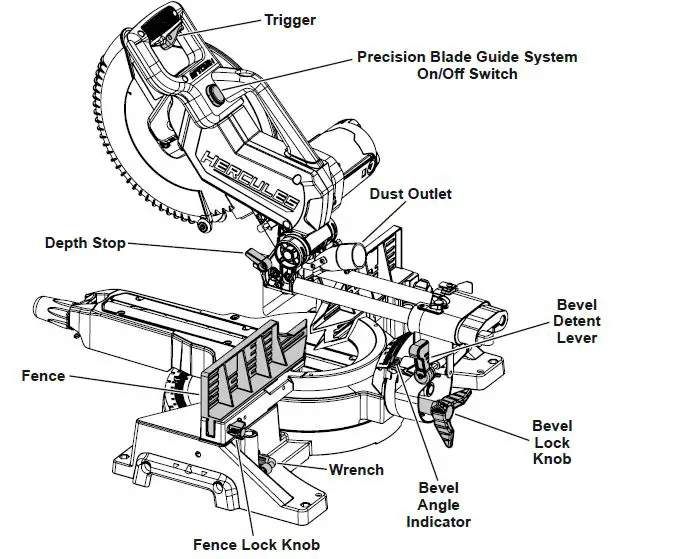
- If replacing a used blade, remove the blade. Install the new Blade. Make sure that the Blade’s rotation arrow points in the same direction as the rotation arrow on the Lower Blade Guard.
- Replace the Outer Flange and Arbor Bolt. Position the cupped side of the Flange against the blade. Hold in the Spindle Lock and wrench tighten the Arbor Bolt by turning it COUNTERCLOCKWISE. Release the Spindle Lock.
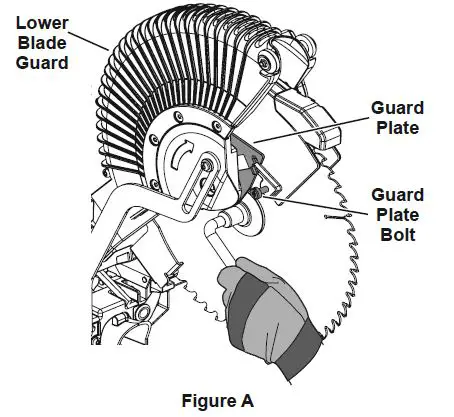
- Rotate the Guard Plate back into place and secure it with the Guard Plate Bolt.
- WARNING! TO PREVENT SERIOUS INJURY: Make sure the Lower Blade Guard operates smoothly and properly protects from the Blade before using the saw.
Adjusting the Miter Angle
A miter cut is one that is at an angle across the horizontal surface of the material. 45º miter cuts to join two pieces in a right angle corner are common. A 30º cut is often used for a scarf joint or to make a chamfered end.
- Loosen the Miter Lock Knob by turning it approximately 1/4 turn counterclockwise.
- Pull up on the Miter Detent Lever to unlock the Table. While holding the Miter Detent Lever up, move the Table to the desired angle.
- The Miter Angle Indicator will indicate the selected angle. While the Miter Detent Lever is released, the Table will lock into place at often used miter angles, including 15º, 22.5º, 30º, and 45º on both left and right sides.
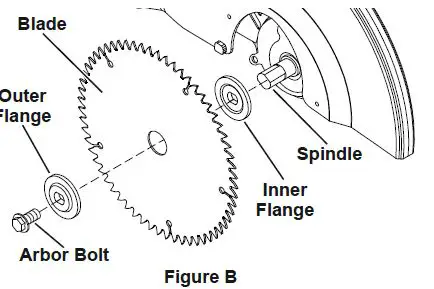
- To override the pre-set detents (stops) for micro adjustments at any angle, pull up on the Miter Detent Lever and push the Detent Latch Button forward and latch in place. Release the Miter Detent Lever and adjust Table to any position on the miter scale. To disengage pull up on the Miter Detent Lever to release the Detent Latch Button.
- Tighten the Miter Lock Knob after adjusting the miter angle.
- With the Table adjusted to the desired angle, place the workpiece flush against the Fence, secure it with the Clamp and make the cut.
Adjusting the Bevel Angle
A bevel cut is one that is at an angle vertically. Bevel cuts can be used to miter relatively wide and thin material. Bevel cuts can be used in combination with a miter cut to form a compound angle. Compound angle cuts are often used in crown moldings, picture frames and similar trim materials.
- Loosen the Bevel Lock Knob at the rear of the saw.
- For micro adjustments at any bevel angle, push the Bevel Detent Lever back until it snaps into place and move the Saw Head Assembly to the desired angle. Read the angle on the Bevel Angle Indicator.
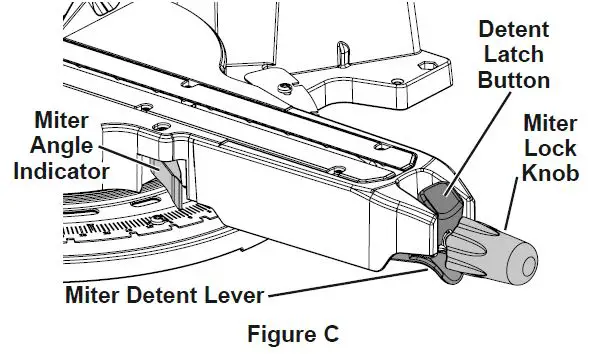
- To use the pre-set detents (stops), push the Bevel Detent Lever back until the Saw Head Assembly can be moved and then release the Lever. The Saw Head Assembly will lock into place at often used bevel angles, including 22.5º, 33.9º, and 45º on both left and right sides.
- Lock the Saw Head Assembly into position by rotating the Bevel Lock Knob clockwise. Tighten firmly but do not over-tighten.
- Make a sample cut in a piece of scrap to confirm that the bevel angle is correct. If it is not, correct the angle before cutting.
WARNING! TO PREVENT SERIOUS INJURY: Adjust both sides of the Fence clear of the Blade’s cutting path after making any adjustment to the cutting angle. Move the Blade through its full range of motion to ensure the Fences are clear.
Using the Depth Stop
If a kerfing or rabbet cut which does not cut through the workpiece is desired, use the Depth Stop to control the depth of the cut.
- Pull out the Head Lock-Down Pin and raise the Saw Head Assembly.
- Rotate the Depth Stop down to a horizontal position to use the Depth Adjustment Bolt setting.
- Pull down on the Saw Head to check the current setting.
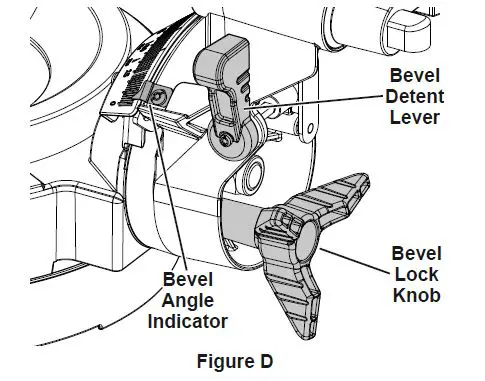
- To change the setting, first loosen the Wing Nut on the Depth Adjustment Bolt. Turn the Depth Adjustment Bolt clockwise to increase depth and counterclockwise to decrease depth. Tighten the Wing Nut after adjustment.
- To disengage, rotate the Depth Stop up to its vertical position.
Workpiece and Work Area Set Up
- Designate a work area that is clean and well lit. The work area must not allow access by children or pets to prevent distraction and injury.
- Route the power cord along a safe route to reach the work area without creating a tripping hazard or exposing the power cord to possible damage. The power cord must reach the work area with enough extra length to allow free movement while working.
- Allow room on both left and right of saw for extended workpieces.
- Use a saw table, saw stand or other means to support the workpiece. Mount the Miter Saw so that the surface is level to the ground, and additional supports provide a surface on the same level as the saw table. If the work surface and any workpiece supports are not level, and on the same level, unwanted bevel angles will appear in the cuts resulting in poor joinery.
- Secure workpieces to the saw table using the Clamp or other clamping devices (not included). Securing the workpiece will provide safety by preventing kick back and by removing the need to hold workpieces near the blade by hand. Clamping the workpiece will also improve cutting accuracy by preventing the workpiece from moving during the cutting operation.
General Operation
DANGER!
MITER SAWS CAN QUICKLY AMPUTATE FINGERS IF MISUSED.
Keep hands well clear of cutting area.
- Press the Saw Head Assembly down and pull out the Head Lock-Down Pin, then release the Saw Head.
- Blow any sawdust or debris away from the Fence. Place the work material against the Fence.
- To use the Precision Blade Guide System to align the cut, turn the Blade Guide System Switch to ON. Pull the Saw Head down until the Saw Blade is close to the workpiece and the Blade’s shadow appears on the work material, indicating where the Blade will cut. Align the marked location of the cut on the workpiece with the edge of the Saw Blade shadow.
- The Saw will also operate without using the Precision Blade Guide System if desired. In that case align the marked location of the cut on the work material with the saw blade. To prevent the workpiece from being cut too short, align the edge of the blade with the measured mark, keeping the rest of the blade on the waste side of the cut.
Note: Hold the work material in place using the Clamp. Ensure that the work material is level and supported securely. Use saw horses or supports if necessary. - Grip the Saw Handle and squeeze the Trigger to start the Saw.
- With narrow material, press down lightly to cut the workpiece. Press straight down, “chopping” the material. Do not bear down on the material use light downward pressure If the material binds the blade, release the Trigger.
- With wide material, move the Blade across the workpiece while cutting as follows:
a. Loosen Slide Lock Knob and pull Saw Head Assembly forward.
b. Press down on the Saw Handle.
c. Push the Saw Head toward the rear to make the cut. Refer to Figure F.
- When the cut is completed, raise the Saw Head, release the Trigger, wait for the Blade to stop turning, release the Clamp and remove the workpiece from the Saw.
- To prevent accidents, turn off the tool and disconnect its power supply after use. Clean, then store the tool indoors out of children’s reach.
MAINTENANCE AND SERVICING
Procedures not specifically explained in this manual must be performed only by a qualified technician.
WARNING
TO PREVENT SERIOUS INJURY FROM ACCIDENTAL OPERATION:
Turn the Power Switch of the tool off and unplug the tool from its electrical outlet before performing any procedure in this section.
TO PREVENT SERIOUS INJURY FROM TOOL FAILURE:
Do not use damaged equipment. If abnormal noise or vibration occurs, have the problem corrected before further use.
Cleaning, Maintenance, and Lubrication
- BEFORE EACH USE, inspect the general condition of the tool. Check for:
- loose hardware
- misalignment or binding of moving parts
- cracked or broken parts
- damaged electrical wiring
- any other condition that may
- AFTER USE, wipe external surfaces of the tool with clean cloth.
- WARNING! TO PREVENT SERIOUS INJURY: If the supply cord of this power tool is damaged, it must be replaced only by a qualified service technician.
Calibrating the Miter Scale
To make accurate cuts, the Saw Blade must be perpendicular (at a 90º angle) to the Fence. To adjust the setting:
- First unplug the tool.
- Lower the Saw Head Assembly and lock it in place using the Head Lock-Down Pin.
- Loosen the Miter Lock Knob by turning it approximately 1/4 turn counterclockwise.
- Pull up on the Miter Detent Lever to unlock the Table and move the Table to the 0º miter position. Release the Miter Detent Lever to lock the Table in position. Do not tighten the Miter Lock Knob.
- Lay a carpenter’s square on the Table with one edge along the Blade and the other along the Fence. Any inaccuracy should be visible. NOTE: The square must contact the surface of the Blade, not the teeth, for an accurate reading.
- If the Fence is not perpendicular (at a 90º angle) to the Saw Blade, loosen the four screws holding the Miter Scale. Using the square to measure, move the Table and Scale together left or right until the Blade and Fence are perpendicular to each other, then tighten the four screws.
- Once the Blade and Fence are perpendicular, check the Miter Angle Indicator and Miter Scale. The Indicator should point to zero. If necessary, loosen the Miter Angle Indicator screw and move the Indicator to zero, then tighten the screw.
Calibrating the Bevel Angle
For making accurate cuts, the Saw Blade must be adjusted to be exactly vertical to the Table. If adjustment is necessary have the Miter Saw serviced by a qualified service technician.
Adjusting or Replacing the Kerf Board
If the Kerf Board becomes damaged it must be replaced.
- Remove the six screws holding the Kerf Board in place.
- Install a new Kerf Board. Replace the six screws and tighten them slightly.
- To adjust the Kerf Board, lower the Saw Head Assembly and lock it in place using the Head Lock-Down Pin.
- Adjust the Kerf Board so the right side of the Blade slightly clears the edge of the Kerf Board.
- Loosen the Bevel Lock and set the Bevel Angle at 45º left.
- Ensure that the left side of the Blade clears the Kerf Board.
- Tighten the six screws holding the Kerf Board in place.
Troubleshooting
| Problem | Possible Causes | Likely Solutions |
| Tool will not start. | 1. No power at outlet.
2. Cord not connected. |
1. Check power at outlet.
2. Check that cord is plugged in. |
| Tool operates sporadically or at low power. | 1. Low power supply or improper extension cords.
2. Worn or cracked Carbon Brushes. |
1. Check power supply and power cords.
2. Check Carbon Brushes. Replace if damaged or worn. |
| Wood burns at ends when cut. | 1. Dirty Blade.
2. Material is binding. |
1. Clean Blade using blade cleaner or mineral spirits.
2. Check position of work material on Table. Material must be flat, flush against Fence and supported on ends. |
| Material frays or chips out. | 1. Finished side is down.
2. Blade chipped or dull. 3. Blade inappropriate for material.
4. Material is unsupported. |
1. Keep finished side of material up or facing operator. Bottom and back side are prone to chip out.
2. Check for damaged teeth. Sharpen or replace blade. 3. Check blade manufacturer’s recommendations for material being cut. For cross cutting hard wood and for precision cuts use a thin kerf blade with 60 or more teeth. 4. Use a thin piece of scrap material, such as 1/4″ plywood, underneath or behind the material to support the edges of the material as it is being cut. |
| Blade binds, slowing or stopping saw. | 1. Material is misaligned on the saw or ends are not supported.
2. Material is wet, contaminated or inappropriate blade is being used. |
1. Material must be flat on table, flush against the fence and supported on both ends.
2. Check condition of material and check compatibility of blade to material. |
| Blade does not cut completely through workpiece. | 1. Depth Stop setting in use.
2. Depth Stop set too shallow. |
1. Swing Depth Stop up to its vertical position to disengage.
2. Adjust Depth Adjustment Bolt for desired depth of cut. |
| Motor runs but blade does not turn. | Drive belt has failed. | Have qualified technician service tool. |
| Follow all safety precautions whenever diagnosing or servicing the tool. Disconnect power supply before service. | ||
Record Product’s Serial Number Here:
Note: If product has no serial number, record month and year of purchase instead.
Note: Some parts are listed and shown for illustration purposes only, and are not available individually as replacement parts. Parts may not be interchangeable. Specify item number when ordering.
PLEASE READ THE FOLLOWING CAREFULLY
THE MANUFACTURER AND/OR DISTRIBUTOR HAS PROVIDED THE PARTS LIST AND ASSEMBLY DIAGRAM IN THIS MANUAL AS A REFERENCE TOOL ONLY. NEITHER THE MANUFACTURER OR DISTRIBUTOR MAKES ANY REPRESENTATION OR WARRANTY OF ANY KIND TO THE BUYER THAT HE OR SHE IS QUALIFIED TO MAKE ANY REPAIRS TO THE PRODUCT, OR THAT HE OR SHE IS QUALIFIED TO REPLACE ANY PARTS OF THE PRODUCT. IN FACT, THE MANUFACTURER AND/OR DISTRIBUTOR EXPRESSLY STATES THAT ALL REPAIRS AND PARTS REPLACEMENTS SHOULD BE UNDERTAKEN BY CERTIFIED AND LICENSED TECHNICIANS, AND NOT BY THE BUYER. THE BUYER ASSUMES ALL RISK AND LIABILITY ARISING OUT OF HIS OR HER REPAIRS TO THE ORIGINAL PRODUCT OR REPLACEMENT PARTS THERETO, OR ARISING OUT OF HIS OR HER INSTALLATION OF REPLACEMENT PARTS THERETO.
PARTS LIST
| Part | Description | Qty |
| 1 | Base | 1 |
| 2 | Foot | 4 |
| 3 | Miter Scale | 1 |
| 4 | M6 x 12 Screw | 2 |
| 5 | M6 x 13 Screw | 2 |
| 6 | Wrench Clamp | 1 |
| 7 | M5 x 10 Screw | 1 |
| 8 | Wrench | 1 |
| 9 | Table Pad | 1 |
| 10 | Table | 1 |
| 11 | Spring Sheet | 1 |
| 12 | M5 x 8 Screw | 1 |
| 13 | M5 x 10 Screw | 2 |
| 14 | M5 x 12 Screw | 2 |
| 15 | Rod | 1 |
| 16 | Retaining Sheet | 1 |
| 17 | M5 x 8 Screw | 1 |
| 18 | Miter Handle Assembly | 1 |
| 19 | Miter Handle | 1 |
| 20 | Detent Latch Button | 1 |
| 21 | 04.5 x 9 Rivet | 2 |
| 22 | Handle Support | 1 |
| 23 | 05 x 45 Pin | 1 |
| 24 | Nut | 2 |
| 25 | Miter Retaining Sheet | 1 |
| 26 | M5 x 13 Screw | 2 |
| 27 | Bolt | 1 |
| 28 | M10 x 69 Bevel Lock Bolt | 1 |
| 29 | M8 x 10 Screw | 1 |
| 30 | Kerf Board | 2 |
| 31 | M4 x 16 Screw | 6 |
| 32 | Miter Angle Indicator | 1 |
| 33 | M4 x 20 Screw | 1 |
| 34 | M8 x 30 Screw | 1 |
| 35 | Washer | 2 |
| Part | Description | Qty |
| 36 | M8 Nut | 1 |
| 37 | Bevel Detent Plate | 1 |
| 38 | Washer | 2 |
| 39 | M5 x 18 Screw | 2 |
| 40 | M5 x 25 Screw | 2 |
| 41 | Wave Washer | 2 |
| 42 | Pivot Assembly | 1 |
| 43 | Front Pivot | 1 |
| 44 | Left Sliding Bar | 1 |
| 45 | Right Sliding Bar | 1 |
| 46 | Pivot | 1 |
| 47 | Linear Bearing | 1 |
| 48 | Linear Bearing | 1 |
| 49 | Bevel Detent Plate | 1 |
| 50 | M5 x 10 Screw | 2 |
| 51 | Bevel Shaft | 1 |
| 52 | Bevel Clamp | 1 |
| 53 | Bevel Lock Handle | 2 |
| 54 | M4 x 12 Screw | 2 |
| 55 | Spring | 1 |
| 56 | Detent Shaft | 1 |
| 57 | Detent Shaft Driving Assembly | 1 |
| 58 | C-Ring | 2 |
| 59 | E-Ring | 1 |
| 60 | Bearing Cover | 2 |
| 61 | Washer | 1 |
| 62 | Felt Washer | 1 |
| 63 | M5 x 10 Set Screw | 2 |
| 64 | Rear Pivot | 1 |
| 65 | Pad | 2 |
| 66 | M8 x 8 Screw | 2 |
| 67 | M6 x 20 Screw | 6 |
| 68 | Rear Pivot Knob | 1 |
| 69 | Spring | 1 |
| 70 | Washer | 1 |
| Part | Description | Qty |
| 71 | Washer | 2 |
| 72 | M16 Nylon Nut | 1 |
| 73 | Stationery Fence | 1 |
| 74 | M8 x 25 Screw | 4 |
| 75 | Left Sliding Fence | 1 |
| 76 | Right Sliding Fence | 1 |
| 77 | Fence Knob | 2 |
| 78 | M6 x 13 Screw | 1 |
| 79 | M6 x 24 Screw | 1 |
| 80 | Washer | 1 |
| 81 | Bevel Lock Handle | 1 |
| 82 | Bevel Scale | 1 |
| 83 | M5 x 16 Screw | 2 |
| 84 | Left Bevel Indicator | 1 |
| 85 | Right Bevel Indicator | 1 |
| 86 | M5 x 8 Screw | 2 |
| 87 | Washer | 2 |
| 88 | Head Lock-Down Pin Assembly | 1 |
| 89 | Head Lock-Down Pin | 1 |
| 90 | O-Ring | 1 |
| 91 | Wear Plate | 2 |
| 92 | Upper Guard | 1 |
| 93 | Linear Bearing | 1 |
| 94 | Shaft Assembly | 1 |
| 95 | 6302 Bearing | 1 |
| 96 | Shaft | 1 |
| 97 | C-Ring | 1 |
| 98 | Pulley | 1 |
| 99 | M5 x 8 Screw | 1 |
| 100 | Spindle and Gear Set | 1 |
| 101 | Bearing Holder | 1 |
| 102 | Needle Bearing | 1 |
| 103 | Spindle | 1 |
| 104 | 6003 Bearing | 1 |
| 105 | Cover | 1 |
| 106 | M4 x 6 Screw | 2 |
| 107 | Reduction Gear | 1 |
| 108 | Pad | 1 |
| 109 | M5 x 16 Screw | 3 |
| 110 | Spring | 1 |
| 111 | Spindle Lock Set | 1 |
| 112 | Spindle Lock | 1 |
| 113 | O-Ring | 1 |
| 114 | Dowel Lock Plate | 1 |
| 115 | M5 x 12 Screw | 1 |
| 116 | Wave Washer | 1 |
| 117 | Shaft Set | 1 |
| 118 | 6202 Bearing | 1 |
| 119 | Shaft | 1 |
| 120 | Cover | 1 |
| Part | Description | Qty |
| 121 | Pulley | 1 |
| 122 | 629 Bearing | 1 |
| 123 | M5 x 16 Screw | 3 |
| 124 | Blade Guide Holder Assembly | 1 |
| 125 | Blade Guide Holder | 1 |
| 126 | Blade Guide Light | 1 |
| 127 | Blade Guide Lens | 1 |
| 128 | Lock Cover | 1 |
| 129 | M5 x 16 Screw | 2 |
| 130 | Wire Cover | 1 |
| 131 | M4 x 15 Screw | 2 |
| 132 | Short Drive Belt | 1 |
| 133 | Dowel | 1 |
| 134 | Pulley | 1 |
| 135 | Washer | 1 |
| 136 | Washer | 1 |
| 137 | M6 x 16 Screw | 1 |
| 138 | Motor Set | 1 |
| 139 | Motor Front Cover | 1 |
| 140 | Armature Assembly | 1 |
| 141 | M5 x 40 Screw | 1 |
| 142 | Field Set | 1 |
| 143 | Motor Housing | 1 |
| 144 | M5 x 5 Screw | 2 |
| 145 | Brush Holder | 2 |
| 146 | Nylon Nut | 2 |
| 147 | Nut Holder | 2 |
| 148 | Field Set | 1 |
| 149 | Hex Shaft | 2 |
| 150 | Power Cord Clip | 1 |
| 151 | Bearing Cover | 1 |
| 152 | Baffle | 1 |
| 153 | Brush | 2 |
| 154 | Brush Cover | 2 |
| 155 | End Cap | 1 |
| 156 | M4 x 16 Screw | 2 |
| 157 | Dowel | 2 |
| 158 | Pulley | 1 |
| 159 | Washer | 1 |
| 160 | Washer | 1 |
| 161 | M6 x 16 Screw | 1 |
| 162 | C-Ring | 1 |
| 163 | M6 x 16 Screw | 2 |
| 164 | M6 x 16 Screw | 2 |
| 165 | Long Drive Belt | 1 |
| 166 | M8 x 16 Screw | 1 |
| 167 | Aluminum Belt Cover | 1 |
| 168 | M5 x 16 Screw | 1 |
| 169 | Belt Cover | 1 |
| 170 | M5 x 16 Screw | 4 |
| Part | Description | Qty |
| 171 | Bushing | 1 |
| 172 | Torsion Spring | 1 |
| 173 | Shaft | 1 |
| 174 | M8 x 15 Screw | 1 |
| 175 | M6 x 16 Screw | 2 |
| 176 | Bottom Handle | 1 |
| 177 | M5 x 16 Screw | 1 |
| 178 | Transformer | 1 |
| 179 | Trigger | 1 |
| 180 | M4 x 8 Screw | 1 |
| 181 | Power Cord | 1 |
| 182 | Bushing | 1 |
| 183 | Terminal | 1 |
| 184 | Cable Clip | 1 |
| 185 | Top Handle | 1 |
| 186 | Blade Guide Switch | 1 |
| 187 | Blade Guide Switch Cover | 1 |
| 188 | M4 x 16 Screw | 3 |
| 189 | M5 x 16 Screw | 4 |
| 190 | Carry Handle | 1 |
| 191 | M5 x 55 Screw | 1 |
| 192 | Block | 1 |
| 193 | M6 x 16 Screw | 1 |
| 194 | Washer | 1 |
| 195 | M6 x 44 Screw | 1 |
| 196 | M6 Wing Nut | 1 |
| 197 | Dust Cover Assembly | 1 |
| 198 | Left Dust Cover | 1 |
| 199 | Right Dust Cover | 1 |
| 200 | M4 x 12 Screw | 4 |
| 201 | Dust Cover | 1 |
| 202 | Nut | 4 |
| 203 | Left Dust Cover Bracket | 1 |
| 204 | Right Dust Cover Bracket | 1 |
| 205 | M4 x 8 Screw | 4 |
| 206 | M4 x 10 Screw | 2 |
| 207 | M4 x 10 Screw | 1 |
| 208 | Slide Stop | 1 |
| 209 | M5 x 13 Screw | 1 |
| 210 | Washer | 1 |
| 211 | Washer | 1 |
| 212 | Lower Guard Bracket | 1 |
| 213 | M5 x 8 Screw | 4 |
| Part | Description | Qty |
| 214 | Cable Clamp | 1 |
| 215 | M5 x 16 Screw | 1 |
| 216 | M5 x 10 Screw | 1 |
| 217 | Cable Clamp | 1 |
| 218 | Inner Flange | 1 |
| 219 | Blade | 1 |
| 220 | Outer Flange | 1 |
| 221 | Arbor Bolt | 1 |
| 222 | Lower Guard Set | 1 |
| 223 | Lower Guard Bracket | 1 |
| 224 | Lower Blade Guard | 1 |
| 225 | M5 x 6 Screw | 4 |
| 226 | Spring | 1 |
| 227 | M5 x 16 Screw | 1 |
| 228 | Bushing | 1 |
| 229 | Guard Plate | 1 |
| 230 | Washer | 1 |
| 231 | M5 Nylon Nut | 1 |
| 232 | Stop Pad | 1 |
| 233 | Lower Guard Pad | 2 |
| 234 | Nut | 2 |
| 235 | M6 x 16 Screw | 2 |
| 236 | Bushing | 2 |
| 237 | Linkage | 1 |
| 238 | M5 x 16 Screw | 2 |
| 239 | Miter Lock Knob | 1 |
| 240 | Dust Collection Bag Set | 1 |
| 241 | Port | 1 |
| 242 | Dust Collection Bag Bracket | 1 |
| 243 | Dust Collection Bag | 1 |
| 244 | Fastener | 1 |
| 245 | Clamp Set | 1 |
| 246 | Clamp Knob | 1 |
| 247 | M16 x 137 Bolt | 1 |
| 248 | Spring Dowel | 1 |
| 249 | Metal Pad | 1 |
| 250 | M5 x 8 Screw | 1 |
| 251 | Washer | 1 |
| 252 | Clamp Rod 015.87 x 200 | 1 |
| 253 | Clamp Arm | 1 |
| 254 | Clamp Lock Knob | 1 |
| 255 | Bushing | 1 |
| 256 | E-Ring | 1 |
LIMITED 90 DAYS WARRANTY
Harbor Freight Tools Co. makes every effort to assure that its products meet high quality and durability standards, and warrants to the original purchaser that this product is free from defects in materials and workmanship for the period of 90 days from the date of purchase.
This warranty does not apply to damage due directly or indirectly, to misuse, abuse, negligence or accidents, repairs or alterations outside our facilities, criminal activity, improper installation, normal wear and tear, or to lack of maintenance. We shall in no event be liable for death, injuries to persons or property, or for incidental, contingent, special or consequential damages arising from the use of our product. Some states do not allow the exclusion or limitation of incidental or consequential damages, so the above limitation of exclusion may not apply to you.
THIS WARRANTY IS EXPRESSLY IN LIEU OF ALL OTHER WARRANTIES, EXPRESS OR IMPLIED, INCLUDING THE WARRANTIES OF MERCHANTABILITY AND FITNESS.
To take advantage of this warranty, the product or part must be returned to us with transportation charges prepaid. Proof of purchase date and an explanation of the complaint must accompany the merchandise.
If our inspection verifies the defect, we will either repair or replace the product at our election or we may elect to refund the purchase price if we cannot readily and quickly provide you with a replacement. We will return repaired products at our expense, but if we determine there is no defect, or that the defect resulted from causes not within the scope of our warranty, then you must bear the cost of returning the product.
This warranty gives you specific legal rights and you may also have other rights which vary from state to state.
Visit our website at: http://www.harborfreight.com
Email our technical support at: [email protected] For technical questions, please call 1-888-866-5797
Copyright© 2017 by Harbor Freight Tools®. All rights reserved. No portion of this manual or any artwork contained herein may be reproduced in any shape or form without the express written consent of Harbor Freight Tools. Diagrams within this manual may not be drawn proportionally. Due to continuing improvements, actual product may differ slightly from the product described herein. Tools required for assembly and service may not be included.
26541 Agoura Road • Calabasas, CA 91302 • 1-888-866-5797